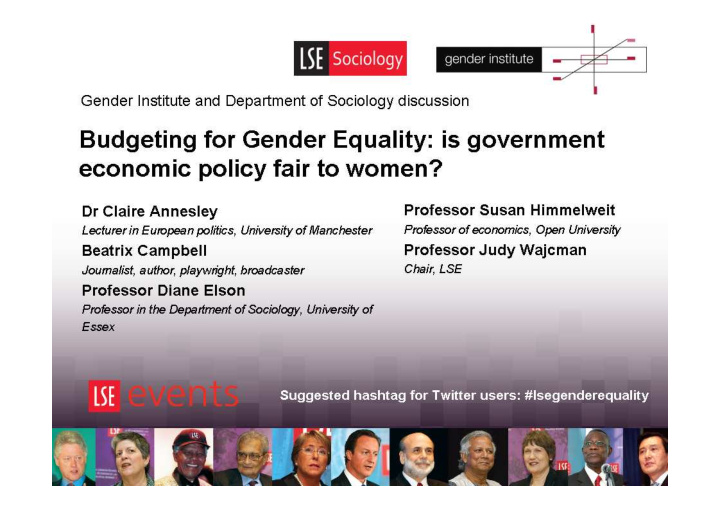



The Gender Impact of the UK government’s recent budgets and spending review Susan Himmelweit, Open University s.f.himmelweit@open.ac.uk UK Women’s Budget Group www.wbg.uk.org
What happens if there is no gender analysis? UK government did not apply any gender analysis to its emergency budget • in June 2010 So Women’s Budget Group did (and to October comprehensive spending • review and March 2011 budget) – network of about 200 academics, members of NGOs and trade unions, mainly women but also some men House of Commons Library audit of the emergency budget • – showed that of the £8bn net revenue to be raised through changes in personal taxes and benefits by 2014-15, almost 75% would be from women – women lost far more from benefits and gained far less from tax breaks – commissioned by Yvette Cooper WBG analysis of October comprehensive spending review • – examined the distributional effects of spending cuts by gendered household types – conducted in co-operation with Howard Reed, Landman Economics see: Tim Horton and Howard Reed Where the Money Goes: How we benefit from public services http://www.tuc.org.uk/extras/wherethemoneygoes.pdf
Effects of spending cuts as % of net income Lone parents suffer a cut worth 18.5% of their cash income (cf 6.85% for • all households): – Like all parents, hit by education cuts, but also by cuts to FE/HE – Also by cuts in housing and social care – Are poor so that cuts form a larger proportion of their income Nearly all lone parents are women • – No significant gender effects within lone parents
Gender effects within pensioners female single couple pensioners male single pensioners pensioners flat-rate 0% change in living standards (annual) -1% other service- -2% related transport -3% -4% housing -5% social care -6% -7% education -8% (HE/FE/skills) -9% education (schools) -10% Single women pensioners more likely to need social care - single so no partner • to look after them, men more likely to be cared for by relatives Older pensioners (mostly women) heaviest users of social care • Single pensioners more likely to live in social housing - men slightly more than • women (NB this does not include cuts in housing benefit) Note transport relatively protected (for now?) • Women are poorer therefore cuts form larger proportion of their income •
Gendered households overall couples single women single men 0% flat-rate -2% other service- change in living standards (annual) related -4% transport -6% housing -8% social care -10% education (HE/FE/skills) education -12% (schools) -14% Singles hit more than couples, but single women most of all • Mostly driven by cuts in social care and housing • And for women particularly HE/FE/skills education and transport • Also women are poorer therefore cuts form a larger proportion of their • income These effects are large •
Gender effects of earning male earners female earners earners of both only only sexes no earners 0% flat-rate change in living standards (annual) -2% other service- -4% related -6% transport -8% housing -10% -12% social care -14% education -16% (HE/FE/skills) -18% education (schools) -20% Households without earners hit particularly hard (NB these are only the • cuts in services) Household with two earners not so badly hit • Male wage protects more than a female wage •
Public Sector Job Losses Women's unemployment now rising faster than men’s even before the • majority of pubic sector job losses Cuts are predicted to lead to between 330,000 and 500,000 public sector • job losses. Despite most women being in ‘protected’ sectors, the majority of jobs lost • will be women’s Though in terms of job losses men paid for the recession more than women, women are paying for this government's “recovery” Gender pay gap is smaller in ‘unprotected’ sectors (-15%) than ‘protected’ • sectors (-23%) so gender pay gap in the public sector will increase overall as a result of the cuts – analysis by Jerome De Henau Any shift from public to private sectors will also increase gender pay gap • Gender pay gap will widen within public sector and in economy as a whole
Recent budget (March 2011) • Perhaps would seek to mitigate gender effects of previous budget and CSR? • Increases in alcohol and tobacco taxes hit households with men more heavily • But these effects dwarfed by those of VAT rise in January, which had highest incidence on poorer households, working age single women (with and without children) and households without a male earner • March budget also included two tax give-aways: – Another increase in the personal allowance which will give £514million to women tax payers but £680 million to men tax payers – A fuel tax cut which mostly went to male single and couple households, particularly those with male earners
Recommend
More recommend